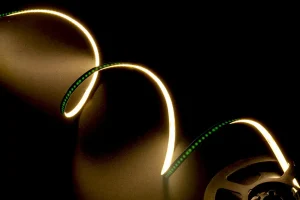SMD LED vs COB LED Strip Light? All of which have its own pros and cons so these differences can help in determining what kind of LED strip you want to use for your specific lighting.
SMD LED strips refers to individual LEDs chips that are placed on the strip (3528, 2835 and 5050 etc – the numbers representing dimensions in millimeters of the respective chip). To elaborate a 5050 SMD LED Strip normally includes chips that are more often than not measuring 5.0mm by 5.0mm and emitting power is greater when compared to smaller tips, therefore; making it perfect for both accent lighting as well as illumination on task basis. In the efficiency race, SMD LEDs are typically more efficient than average, usually offering anywhere between 80-100 lumens per watt which strikes a well-balanced medium of consuming energy but giving off strong light output. Their usefulness in both home and commercial areas has accelerated the LED markets, with worldwide revenues to grow by about 15% per year, owing to their substantial growth of SMD led stripGYCCKT YK51.
On the other hand, the manufacturing process in COB (Chip on Board) LED strips is different where numerous chips (LEDs) are placed in a single substrate without individual packaging. This results in a continuous line of light, with fewer gaps or dark spots visible in SMD LED strips. COB LED strips are very popular in applications where even light distribution is paramount like photography studios, retail displays, and architectural lighting installations. The density of the chips in COB LEDs can reach 300 chips per meter for a continuous illumination, and that provide about 110-120 lumens per watt. There is an added cost to this high density, compared to SMD LED strips in the shape of a more complex production process.
The heat dissipation between SMD LED strip and COB LED strip is quite different. SMD LEDs produce mild heat, which can be usually managed by simple heatsinks that leads them to last 50,000 hours. On the contrary, with their high chip density and monolithic design, COB LEDs need sophisticated heat management solutions to retain high efficacy and drive out their life span. Despite these considerations, COB LEDs may have similar lifespans if the circumstances are ideal and this can make them a viable option for high end applications that require minimal maintenance costs.

From a standpoint of utility, SMD LED strip are significantly further adaptable to cut and molding, furnishing sliced focuses with certain inches between them taking into account flawless installation over tight territories that require correct lengths. What more is that the RGB and RGBW SMD options make them even more appealing as they are also color-changing providing dynamic colors for entertainment venues, restos & modern homes. Conversely, Color Changing COB LED strips do not achieve the same success with color changing but perform exceedingly well in monochrome applications and yielding an ultra-smooth line of light output.
In the end, SMD and COB LED strips can be served especially for lighting needs but only few ranges are different; the rest is determined by cost or lighting effect (where heat management may also take a role). The Strips: more value under floorLow power, fewer price (image courtesy of obsessed by light)An SMD LED allows project to illuminate and personalize for a limited one, while COB LED strips are bean form projects that want continuous prospect on the version.
